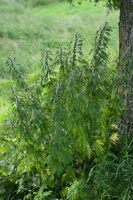- sort orderDefault
Photo title, A → Z
Photo title, Z → A
✔ Date created, new → old
Date created, old → new
Date posted, new → old
Date posted, old → new
Visits, high → low
Random - Google Map
- map
 home / Plantae · augalai / Lamiaceae · notreliniai / Leonurus cardiaca · paprastoji sukatžolė
home / Plantae · augalai / Lamiaceae · notreliniai / Leonurus cardiaca · paprastoji sukatžolė

Leonurus cardiaca · paprastoji sukatžolė
- motherwort, throw-wort, lion's ear, lion's tail
- Echte Herzgespann, Löwenschwanz, Herzspannkraut
- paprastoji sukatžolė
- sirds mātere
- serdecznik pospolity, gęsia stopa, lisi ogon, lwie serce
https://en.wikipedia.org/wiki/Leonurus_cardiaca Originally from Central Asia and southeastern Europe, it is now found worldwide, spread largely due to its use as a herbal remedy.
Leonurus cardiaca has a squarish stem which is clad in short hairs and is often purplish, especially near the nodes. The opposite leaves have serrated margins and are palmately lobed with long petioles; basal leaves are wedge shaped with three points while the upper leaves have three to five. They are slightly hairy above and greyish beneath. Flowers appear in leaf axils on the upper part of the plant and have three-lobed bracts. The calyx of each flower is bell-shaped and has five lobes. The corolla is irregular, 8 to 12 mm long, fused, long-tubed with two lips. The upper lip is convex and covered with white hairs and the lower lip is three-lobed and downward-curving and spotted with red. The flowers are pink to lilac in colour often with furry lower lips. There are four protruding stamens, two short and two longer, and the fruit is a four-chambered schizocarp. The plant grows to about 60 to 100 cm in height and blooms in mid to late summer.
Natūraliai auga Vidurinėje Azijoje, Sibire, Europoje, Artimuosiuose Rytuose. Augalas daugiametis, iki 1,5 m aukščio. Stiebas tiesus, status, šakotas, keturbriaunis, tuščiaviduris. Lapai minkšti, plaštakiškai skiautėti, nežymiai plaukuoti. Žiedynas ilgas, žiedai smulkūs, lapų pažastėlėse susitelkę į smulkius menturius. Vainikėlis rožinis arba baltas. Bręstant sėkloms menturiai tampa dygūs. Žydi birželio-rugsėjo mėnesiais. Auga panamėse, patvoriuose, dykvietėse, šiukšlynuose. Medingas, stiebai tinkami pluošto gamybai, nuoviras – dažymui.

